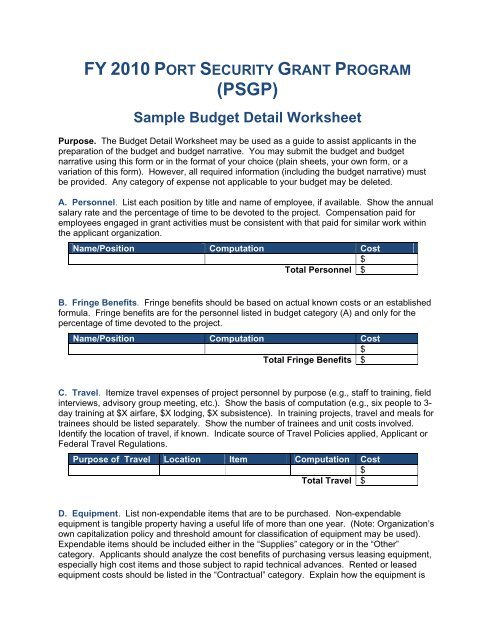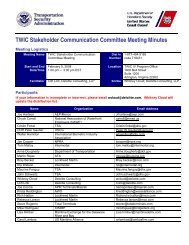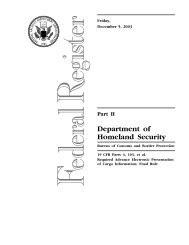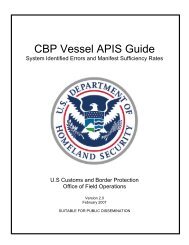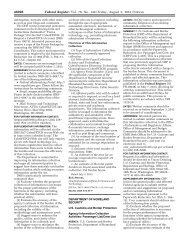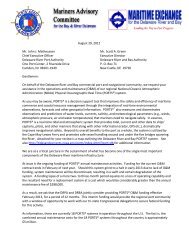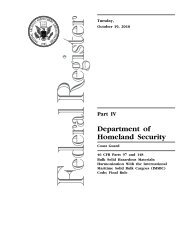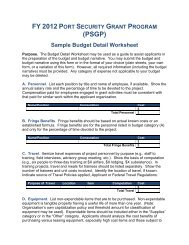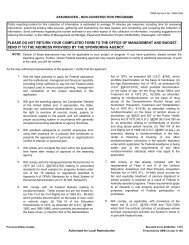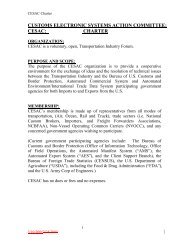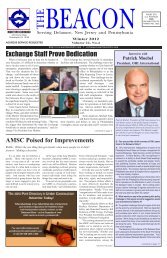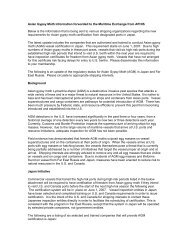(PSGP) Sample Budget Detail Worksheet
(PSGP) Sample Budget Detail Worksheet
(PSGP) Sample Budget Detail Worksheet
You also want an ePaper? Increase the reach of your titles
YUMPU automatically turns print PDFs into web optimized ePapers that Google loves.
FY 2010 PORT SECURITY GRANT PROGRAM<br />
(<strong>PSGP</strong>)<br />
<strong>Sample</strong> <strong>Budget</strong> <strong>Detail</strong> <strong>Worksheet</strong><br />
Purpose. The <strong>Budget</strong> <strong>Detail</strong> <strong>Worksheet</strong> may be used as a guide to assist applicants in the<br />
preparation of the budget and budget narrative. You may submit the budget and budget<br />
narrative using this form or in the format of your choice (plain sheets, your own form, or a<br />
variation of this form). However, all required information (including the budget narrative) must<br />
be provided. Any category of expense not applicable to your budget may be deleted.<br />
A. Personnel. List each position by title and name of employee, if available. Show the annual<br />
salary rate and the percentage of time to be devoted to the project. Compensation paid for<br />
employees engaged in grant activities must be consistent with that paid for similar work within<br />
the applicant organization.<br />
Name/Position Computation Cost<br />
$<br />
Total Personnel $<br />
B. Fringe Benefits. Fringe benefits should be based on actual known costs or an established<br />
formula. Fringe benefits are for the personnel listed in budget category (A) and only for the<br />
percentage of time devoted to the project.<br />
Name/Position Computation Cost<br />
$<br />
Total Fringe Benefits $<br />
C. Travel. Itemize travel expenses of project personnel by purpose (e.g., staff to training, field<br />
interviews, advisory group meeting, etc.). Show the basis of computation (e.g., six people to 3-<br />
day training at $X airfare, $X lodging, $X subsistence). In training projects, travel and meals for<br />
trainees should be listed separately. Show the number of trainees and unit costs involved.<br />
Identify the location of travel, if known. Indicate source of Travel Policies applied, Applicant or<br />
Federal Travel Regulations.<br />
Purpose of Travel Location Item Computation Cost<br />
$<br />
Total Travel $<br />
D. Equipment. List non-expendable items that are to be purchased. Non-expendable<br />
equipment is tangible property having a useful life of more than one year. (Note: Organization’s<br />
own capitalization policy and threshold amount for classification of equipment may be used).<br />
Expendable items should be included either in the “Supplies” category or in the “Other”<br />
category. Applicants should analyze the cost benefits of purchasing versus leasing equipment,<br />
especially high cost items and those subject to rapid technical advances. Rented or leased<br />
equipment costs should be listed in the “Contractual” category. Explain how the equipment is
necessary for the success of the project. Attach a narrative describing the procurement method<br />
to be used.<br />
<strong>Budget</strong> Narrative: Provide a narrative budget justification for each of the budget items<br />
identified.<br />
Item Computation Cost<br />
$<br />
Total Equipment $<br />
E. Supplies. List items by type (office supplies, postage, training materials, copying paper, and<br />
other expendable items such as books, hand held tape recorders) and show the basis for<br />
computation. (Note: Organization’s own capitalization policy and threshold amount for<br />
classification of supplies may be used). Generally, supplies include any materials that are<br />
expendable or consumed during the course of the project.<br />
Supply Items Computation Cost<br />
$<br />
Total Supplies $<br />
F. Consultants/Contracts. Indicate whether applicant’s formal, written Procurement Policy or<br />
the Federal Acquisition Regulations are followed.<br />
Consultant Fees: For each consultant enter the name, if known, service to be provided, hourly<br />
or daily fee (8-hour day), and estimated time on the project.<br />
<strong>Budget</strong> Narrative: Provide a narrative budget justification for each of the budget items<br />
identified.<br />
Name of Consultant Service Provided Computation Cost<br />
$<br />
Subtotal – Consultant Fees $<br />
Consultant Expenses: List all expenses to be paid from the grant to the individual consultant in<br />
addition to their fees (i.e., travel, meals, lodging, etc.)<br />
<strong>Budget</strong> Narrative: Provide a narrative budget justification for each of the budget items<br />
identified.<br />
Item Location Computation Cost<br />
$<br />
Subtotal – Consultant Expenses $<br />
Contracts: Provide a description of the product or services to be procured by contract and an<br />
estimate of the cost. Applicants are encouraged to promote free and open competition in<br />
awarding contracts. A separate justification must be provided for sole source contracts in<br />
excess of $100,000.<br />
<strong>Budget</strong> Narrative: Provide a narrative budget justification for each of the budget items<br />
identified.<br />
Item<br />
Cost
$<br />
Subtotal – Contracts $<br />
Total Consultants/Contracts $<br />
G. Other Costs. List items (e.g., reproduction, janitorial or security services, and investigative<br />
or confidential funds) by major type and the basis of the computation. For example, provide the<br />
square footage and the cost per square foot for rent, and provide a monthly rental cost and how<br />
many months to rent.<br />
<strong>Budget</strong> Narrative: Provide a narrative budget justification for each of the budget items<br />
identified.<br />
Important Note: If applicable to the project, construction costs should be included in this<br />
section of the <strong>Budget</strong> <strong>Detail</strong> <strong>Worksheet</strong>.<br />
Description Computation Cost<br />
$<br />
Total Other $<br />
H. Indirect Costs. Indirect costs are allowed only if the applicant has a federally approved<br />
indirect cost rate. A copy of the rate approval, (a fully executed, negotiated agreement), must<br />
be attached. If the applicant does not have an approved rate, one can be requested by<br />
contacting the applicant’s cognizant Federal agency, which will review all documentation and<br />
approve a rate for the applicant organization, or if the applicant’s accounting system permits,<br />
costs may be allocated in the direct costs categories.<br />
Description Computation Cost<br />
$<br />
Total Indirect Costs $<br />
<strong>Budget</strong> Summary - When you have completed the budget worksheet, transfer the totals for<br />
each category to the spaces below. Compute the total direct costs and the total project costs.<br />
Indicate the amount of Federal funds requested and the amount of non-Federal funds that will<br />
support the project.<br />
<strong>Budget</strong> Category Federal Amount Non-Federal Amount<br />
A. Personnel $ $<br />
B. Fringe Benefits $ $<br />
C. Travel $ $<br />
D. Equipment $ $<br />
E. Supplies $ $<br />
F. Consultants/Contracts $ $<br />
G. Other $ $<br />
H. Indirect Costs $ $<br />
Total Requested<br />
Total Non-Federal
Federal Amount<br />
Amount<br />
$ $<br />
Combined Total Project Costs<br />
$


